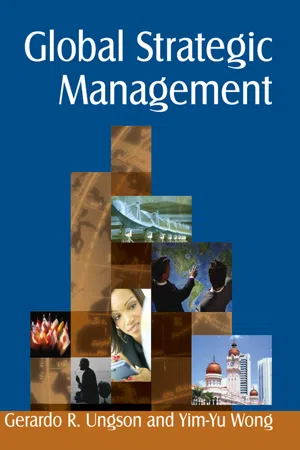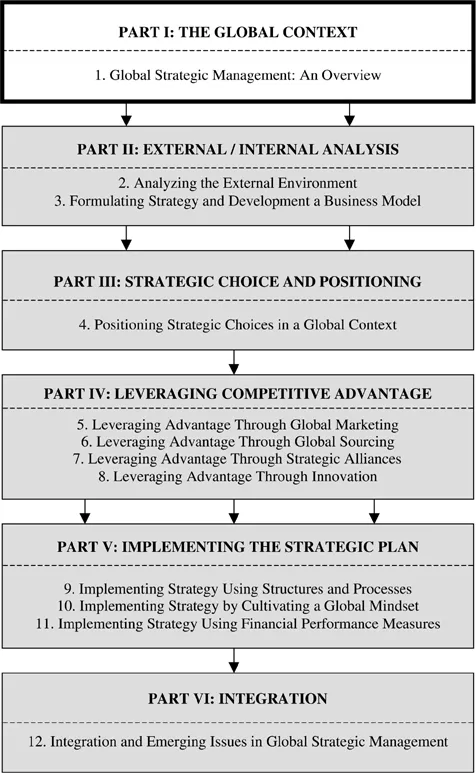![]()
![]()
The future does not begin tomorrow … it began yesterday.
—Anonymous
The best way to predict the future is to invent it.
—Alan Kay
CHAPTER OUTLINE
• Two Global Scenarios
• The Changing Competitive Landscape
• Key Challenges Facing Managers
• Defining Globalization
• The Dark Side of Globalization
• Globalization in a Historical Context
• A Synthesis of Globalization: Implications for Management
• The Global Imperative
• A Framework for Global Strategic Management
LEARNING OBJECTIVES
• Understand the challenges faced by the contemporary manager.
• Understand what globalization is.
• Know the benefits and costs of globalization.
• Understand the three phases of globalization in historical perspective.
• See how globalization specifically affects management.
• Understand the reasons why a firm should go global.
• Understand and follow the framework for global strategic management.
TWO GLOBAL SCENARIOS
Imagine yourself as a manager in the near future. You have been asked to identify and understand the key drivers that will shape the global future. The exercise will be useful for you and your associates in terms of anticipating change, understanding the dynamics that create such change, and positioning a future strategy that capitalizes on the opportunities presented by these future scenarios. Compiled below are two global scenarios based on numerous analyses and extrapolations. Which scenario might become the basis of your future assessment?
SCENARIO 1: 2025—FAVORABLE
Globalization—the growing interconnectedness reflected in expanded trade, information, capital, goods, services, and people—has become a ubiquitous force in society and the economy. The collaboration between governments, corporations, the scientific sector, and communities has produced relative prosperity, global peace, and security; in particular, gaps in income distribution, poverty, hunger, and communicable diseases have been radically reduced. Technological advances, particularly molecular manufacturing (nanotechnology), have lowered the impact of a world population approaching 10 billion. Vaccines and genetic engineering have virtually eliminated most acquired and inherited diseases.1 China and India have emerged as key economic players, and even the poorest countries have been able to leverage cheap technologies to work, albeit a slower rate, to their advantage. To the surprise of the world’s environmentalists, China reversed its previously poor record of cleaning its natural environment. At this time, just enough steel, coal, oil, and railroads have developed to link township and village enterprises (xiangzhen qiye) all over the country.2 More firms have become global, more diverse, both in size and origin, and have actively promoted and diffused technologies that have, in turn, further integrated the world economy and promoted progress in the developing world. The wave of democratization, particularly among the states of the former Soviet Union and Southeast Asia, has gained ground. The previously volatile Middle East region has stabilized with political Islam creating an authority transcending national boundaries. Such stability has muted terrorism, which, while existent, is now a much smaller force than at its pinnacle on 9/11.3
SCENARIO 2: 2025—PESSIMISTIC
Globalization, once considered an irreversible force, has slowed, as a result of catastrophic regional wars, calamitous weather systems, natural disasters, and a global depression. The failure of global communities to resolve many major flashpoints all over the world has created a power vacuum, with cultural “silos” (walled-off nations and regions) emerging after increases in global conflicts.4 New technology has significantly enriched the already rich nations and enterprises, but has also accelerated the gap between the worlds’ very rich and very poor, exacerbating the fear and tension that have smoldered for years. Excluded from the benefits of capitalism and ignored by developed countries, the developing world resents the rise of China and India, seemingly the only beneficiaries of globalization.5 But even a different China has emerged, one that has collapsed into a morass of decadence, corruption, and greed. As feared by critics some decades earlier, China’s environment has become a sewer of damage and waste. With China’s insatiable demand for oil and other energy sources, major disruptions of oil supplies have sharply increased the price of oil and gasoline.6 The disregard for the Kyoto Protocols by the United States, Australia, and a growing host of countries has exacerbated global warming, leading to calamitous weather patterns and natural disasters. Global terrorism has reached new heights with newly organized military cells in the Middle East and Asia, fueled by the rise of poverty throughout the world.7
THE CHANGING COMPETITIVE LANDSCAPE
Managerial actions comprise decisions about the future. It is thus widely acknowledged that the methodology of scenario forecasting, along the lines presented in the opening example, will grow in importance. Scenarios not only project images of the future, but also engage individuals in the process of examining their underlying assumptions about how decisions and events might lead to one outcome or another. This process lends itself to purposeful thinking about resources and capabilities and the extent to which they are suited for possible actions in some future state. Scenarios are intriguing not so much because of their projections, but because they represent a microcosm of managerial challenges that reflect the possibility of deep change and transformation in the future. Thinking critically and purposefully about change, transformation, and future states involves a systematic process—one that is further developed in this book. It is little wonder that the renowned poet Charles Kittering once said: “I’m interested in the future because I will be spending the rest of my life there.” In a different light, the futurist Peter Bishop remarked: “The present is but a temporary condition.”
For a perspective on changes and transformations, let us go back for a moment to the 1980s.8 Some readers will remember this period vividly, while others who were growing up at the time might have to ask their parents about it. In 1980, the United States was in an economic shambles, with the “misery index” (inflation plus unemployment) at its height in 1980. The inflation rate stood at 14 percent, the unemployment rate at over 10 percent, and the interest rate at 21 percent. In the area of technology, the prototype music compact disk (CD) was introduced at the end of the 1970s. There were no high-speed fax machines. The VCR was still in its infancy. The very earliest cable television stations, like HBO, catered to small audiences, and CNN had just been launched. Mobile music, such as Sony’s Walkman, was hardly in existence. But perhaps more conspicuously, the use of personal computers was limited and rudimentary, and certainly there were no wireless cell phones. The economic hegemony of the United States was threatened by an Asian superpower, Japan. Best-selling books at the time extolled the virtues of the Japanese economy and impelled U.S. firms to emulate Japanese management philosophies, management practices, and work methods.9 With an eye toward the new millennium, the twenty-first century was dubbed as the “Asian century,” but this was in reference to Japan, not China or India.
Not surprisingly, in numerous conferences over the years, the question posed to business leaders has been: “What key trends will have the most impact on the future survival and success of your organization?” Most, if not all, respond: “Change, discontinuity, uncertainty.” While the changes foreseen are consistent with the experiences faced by business managers for several decades, they seem to be more intense at present. Consider some representative responses:
• About competition: “Competitors are much more varied than before; they come from different parts of the world; they bring in very different business models. Because competition is much more intense, it’s hard to maintain and sustain the competitive advantage. The weathered rules about cost efficiency or having better quality don’t seem to hold. More nimble competitors have trumped many established market leaders. And this is assuming managers can identify their competitors; on some occasions, they cannot….”
• About customers: “They have become more knowledgeable and certainly much more demanding. Because of their direct access to the Internet, they usually check on comparative prices before they even visit the store. The new technology has afforded them so many choices. As a result, they are less loyal; if they are not satisfied with a single incidence of less-than-expected service, they will not hesitate to leave.”
• About change and technology: “It is true that firms can exploit new technological advances. Yet, because of continuous improvement in cost and del...

